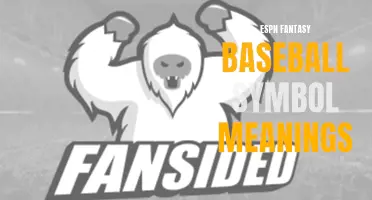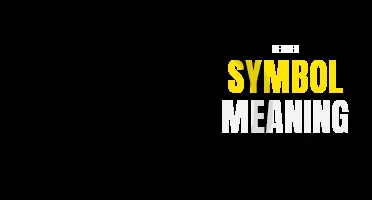
Peru, a country rich in vibrant culture and history, is home to a variety of intriguing symbols that hold deep significance. These symbols, whether found in their flag, national emblem, or ancient artifacts, reveal the stories and beliefs of the Peruvian people. From the iconic condor, which represents freedom and power, to the Inti raymi, a dazzling sun festival celebrating the Inca sun god, each symbol tells a captivating tale that connects past and present, indigenous traditions and modern identity. Join me as we unravel the meanings behind these captivating symbols and delve into the fascinating world of Peru's cultural heritage.
What You'll Learn
- What are some of the national symbols of Peru and what do they represent?
- What is the significance of the condor in Peruvian culture and what does it symbolize?
- What is the meaning behind the colors and patterns used in traditional Peruvian textiles?
- Are there any significant symbols or designs associated with the Inca civilization in Peru?
- How do ancient symbols and traditions continue to be important in modern Peruvian society?

What are some of the national symbols of Peru and what do they represent?
Peru, a country located on the western coast of South America, is known for its rich history and vibrant culture. Throughout the years, Peru has developed several national symbols that represent its diverse heritage and national pride. These symbols serve as visual representations of Peru's unique identity and are deeply ingrained in the hearts of its people.
One of the most recognizable national symbols of Peru is the national flag. The flag consists of three vertical bands of red, white, and red, with the coat of arms centered in the white band. The red bands symbolize bravery and valor, while the white band represents peace and purity. The coat of arms consists of a vicuña, which is a national animal representing Peru's wildlife, surrounded by a wreath of palm and laurel branches. This emblem symbolizes liberty and abundance.
Another important national symbol is the national anthem of Peru, called "Himno Nacional del Perú." Written by José de la Torre Ugarte and composed by José Bernardo Alcedo, the anthem celebrates the bravery and sacrifice of Peruvian heroes throughout history. It reflects the country's struggle for independence and its ongoing quest for freedom.
The national flower of Peru is the cantuta. This beautiful flower, also known as the Inca's Flower, is native to the Andean region and holds great cultural significance. It was revered by the Incas and is still considered a symbol of power, abundance, and devotion. The cantuta comes in various colors, including red, yellow, and purple, further symbolizing the diversity and beauty of Peru.
Peru is well-known for its ancient ruins, with Machu Picchu being one of the most iconic sites in the country. This archaeological wonder is also considered a national symbol and represents Peru's rich history and architectural prowess. It showcases the ingenuity of the Incas and their advanced engineering skills. Machu Picchu is a testament to Peru's ancient civilization and continues to attract tourists from around the world.
In addition to these symbols, Peru also has a national bird called the Andean cock-of-the-rock. This colorful bird with its distinctive crest is highly regarded and represents the country's biodiversity. It is known for its vibrant orange feathers and unique courtship displays, symbolizing the beauty and natural wonders found in Peru.
Overall, the national symbols of Peru reflect the country's cultural heritage, natural beauty, and historical significance. Whether it is the flag, anthem, flower, ancient ruins, or wildlife, these symbols encapsulate the essence of Peru and its diverse identity. They serve as a source of national pride for Peruvians and a reminder of their rich past and bright future.
The Symbolic Meaning of the Number 5: Unleashing the Power of Change
You may want to see also

What is the significance of the condor in Peruvian culture and what does it symbolize?
The condor holds great significance in Peruvian culture, and it is deeply rooted in the country's history, mythology, and symbolism. As the largest flying bird in the world, the condor is seen as a powerful and majestic creature that captures the imagination of the Peruvian people.
In Peruvian mythology, the condor is often associated with the heavens and is considered a messenger between the earthly world and the spiritual realm. It is believed to possess exceptional wisdom and is revered as a symbol of power, strength, and freedom. The condor is considered to be a guardian and protector, watching over the land and its people.
One of the key reasons why the condor holds such significance in Peruvian culture is its relationship with the Andes Mountains. The condor can often be seen soaring high above the mountain peaks, and its ability to fly at such heights is seen as a representation of its connection to the spiritual realm. The Andes Mountains are considered sacred in Peruvian culture, and the condor is seen as a spiritual guide that helps navigate the vast and rugged terrain.
In addition to its connection to the spiritual world, the condor also holds symbolic value in Peruvian culture. It is often associated with the sun due to its ability to soar high in the sky and its black and white feathers that resemble the sun's rays. The condor is seen as a representation of the sun's energy and vitality, and it is considered a symbol of renewal and rebirth.
Furthermore, the condor is also linked to the concept of duality in Peruvian culture. Its black and white feathers symbolize the balance between light and darkness, good and evil, life and death. The condor is seen as a mediator between these opposing forces, reminding people of the importance of finding equilibrium in their lives.
The condor is frequently depicted in Peruvian art, textiles, and jewelry. Its image can be found in ancient Inca ruins and contemporary artwork, showcasing its enduring cultural significance. The condor is also celebrated in various festivals and rituals, where it is honored through music, dance, and traditional ceremonies.
Despite the condor's importance in Peruvian culture, it is currently facing numerous threats, including habitat loss and hunting. Efforts are being made to protect the condor and raise awareness about its significance and conservation. Organizations and local communities are working together to ensure the survival of this iconic bird and to preserve its cultural and spiritual importance in Peruvian society.
In conclusion, the condor holds great significance in Peruvian culture and symbolizes power, strength, freedom, and the connection between the earthly and spiritual realms. It is deeply intertwined with the Andes Mountains, the sun, duality, and renewal. The condor's image can be seen in Peruvian art, and it is celebrated in festivals and ceremonies. The condor's conservation is of utmost importance to preserve its cultural and spiritual value in Peruvian society.
Exploring Nigerian Symbols: Uncovering the Meanings Behind Rich Cultural Icons
You may want to see also

What is the meaning behind the colors and patterns used in traditional Peruvian textiles?
Traditional Peruvian textiles are known for their vibrant colors and intricate patterns, which hold deep cultural and historical significance. These textiles have been a significant part of Peruvian culture for thousands of years and are a source of pride for the Peruvian people. The meaning behind the colors and patterns used in these textiles varies depending on the region and the specific community, but there are some common themes that can be observed.
Colors play a crucial role in Peruvian textiles as they represent different aspects of life and nature. The most commonly used colors are red, yellow, blue, green, and purple. Red symbolizes the earth and the Pachamama (Mother Earth) and represents energy and vitality. Yellow represents the sun and gold - which is associated with abundance and wealth. Blue symbolizes the sky and water, signifying harmony and tranquility. Green represents plants and agriculture, symbolizing fertility and growth. Lastly, purple is often associated with royalty and represents power and respect.
Patterns in Peruvian textiles are rich in symbolism and often tell stories of the community's history and traditions. Some common patterns found in these textiles include geometric shapes, animals, and plants. Geometric shapes such as triangles, squares, and diamonds represent the four elements - earth, air, fire, and water. These shapes also symbolize the connection between the physical and spiritual worlds. Animals are often depicted in Peruvian textiles and hold specific meanings. For example, the condor represents freedom and power, the snake represents transformation and renewal, and the puma represents strength and bravery. Plants, such as corn and potatoes, are essential elements in Peruvian agriculture and are often depicted in textiles to symbolize fertility and abundance.
In addition to these common symbols, each region and community in Peru has its unique patterns and designs that represent its specific identity and history. These patterns may be passed down through generations and are a way to preserve and celebrate the community's cultural heritage. The intricate weaving techniques used to create these textiles are also an important part of the cultural tradition, and the weavers often infuse their personal creativity and skills into each piece.
Overall, traditional Peruvian textiles are a testament to the rich cultural heritage of the Peruvian people. The vibrant colors and intricate patterns hold deep significance and tell stories of the community's history, traditions, and connection to nature. Whether worn as clothing or used as decorative pieces, these textiles are a proud representation of Peruvian culture and continue to be cherished and celebrated by both locals and visitors alike.
The Deep Symbolism and Spiritual Significance of the Hatumi Symbol Revealed
You may want to see also

Are there any significant symbols or designs associated with the Inca civilization in Peru?
The Inca civilization, which once thrived in what is now modern-day Peru, left behind a significant legacy in terms of art and design. Among their numerous achievements, the Incas developed a rich symbolism that is still recognized and admired today. These symbols and designs are not only visually stunning but also carry deep cultural and spiritual significance.
One of the most well-known symbols associated with the Inca civilization is the Inti Raymi, or "Festival of the Sun." The Incas revered the sun as their primary deity, and the Inti Raymi was an annual celebration to honor and appease this powerful entity. The symbol of the sun, known as the Inti, was frequently depicted in Inca art. It is often portrayed as a golden disc with a face, representing the sun's life-giving power and benevolence.
Another important symbol associated with the Incas is the Chakana, also known as the Andean Cross. This cross-like design consists of a stepped motif with triangular shapes on each step. It is believed to represent the three levels of existence in the Inca cosmology: the lower world (Ukhu Pacha), the present world (Kay Pacha), and the upper world (Hanan Pacha). The Chakana is seen as a symbol of balance and harmony, connecting various aspects of life and the spiritual realm.
Inca textiles, renowned for their intricate designs, are another significant aspect of Inca symbolism. These textiles were much more than mere fabrics; they were artistic masterpieces that embodied the Inca's deep connection to nature and the spiritual realm. The designs on Inca textiles often depict animals, plants, and geometric shapes, each carrying its own symbolic meaning. For example, the condor, the largest flying bird in the world, was a symbol of power and divinity, while geometric patterns represented the interconnectedness of all living things.
The Inca civilization also left behind an impressive architectural legacy, with Machu Picchu being the most iconic example. The design of Machu Picchu and other Inca structures incorporated many intricate elements connected to their symbolism. For instance, the use of trapezoidal doorways and windows is believed to represent the sacred mountains surrounding the site.
In addition to symbols and designs, the Incas also developed a sophisticated system of communication using a series of knotted cords known as quipu. These quipus were made from different colored cords and knots, and they served as a record-keeping tool for the Inca society. The knots and cords were arranged in a specific pattern to convey information such as population censuses, agricultural production, and historical events. While the exact meaning of these quipus is still a subject of debate among scholars, they are undeniably an important symbol of the Incas' advanced civilization.
In conclusion, the Inca civilization in Peru has left behind a rich legacy of symbols and designs. From the Inti Raymi to the Chakana and the intricate textiles, these symbols not only showcase the artistic abilities of the Incas but also provide a glimpse into their deeply spiritual and interconnected worldview. The Inca's use of symbols and designs in their art, architecture, and communication continues to inspire awe and admiration, making their civilization a truly remarkable chapter in human history.
The Symbolic Power Behind Oshun Tattoos: Unveiling the Meaning Behind This Ancient Lwa
You may want to see also

How do ancient symbols and traditions continue to be important in modern Peruvian society?
Ancient Symbols and Traditions: A Cultural Heritage in Modern Peruvian Society
Peru is a country rich in cultural diversity and heritage, with a history that dates back thousands of years. Ancient symbols and traditions continue to hold great importance in modern Peruvian society, as they are a testament to the country's deep-rooted beliefs and values.
One of the most prominent ancient symbols that has retained its significance in Peruvian culture is the Inca Cross, also known as the Chakana. This symbol represents the three worlds of the Inca cosmology: the lower world (Ukhu Pacha), the present world (Kay Pacha), and the upper world (Hanan Pacha). The Chakana is often seen on traditional garments, jewelry, and even in contemporary art, serving as a reminder of the interconnectedness of life and the spiritual beliefs of the past.
Another symbol that continues to be important in modern Peruvian society is the Inti Raymi or "Festival of the Sun." This ancient Inca celebration, which takes place during the winter solstice, honors Inti, the sun god. It is a time of gratitude and reverence for the sun's life-giving energy. The Inti Raymi festival attracts locals and tourists alike, as it showcases traditional dances, music, and rituals that have been passed down through generations. The festival serves as a reminder of the country's agricultural heritage and the importance of the sun in Peruvian society.
Traditional weaving techniques also play a significant role in modern Peruvian society. The intricate patterns and designs found in textiles are a testament to the skill and craftsmanship of the indigenous communities. These textiles often depict ancient symbols and motifs, such as the Inti (sun), Puma (mountain lion), and the Serpent. Peruvian weavers have managed to preserve these ancient traditions by incorporating them into contemporary fashion, creating a unique blend of old and new.
In addition to symbols, ancient traditions continue to be an integral part of Peruvian society. One such tradition is the ceremony of Ayahuasca, a powerful plant medicine used for spiritual and healing purposes. The ceremony involves the consumption of the Ayahuasca brew, which is believed to open a gateway to the spiritual realm. Despite being thousands of years old, Ayahuasca ceremonies are still practiced today, attracting people from around the world who seek personal transformation and spiritual enlightenment.
Furthermore, traditional music and dance are deeply ingrained in Peruvian culture. The Andean flute, panpipes, and traditional drums are still used to perform traditional melodies that have been passed down through generations. Dance forms like the Marinera and Huayno are also commonly practiced and performed at cultural events and festivals. These performances serve as a celebration of Peruvian heritage and a way to keep ancient traditions alive.
In conclusion, ancient symbols and traditions continue to be important in modern Peruvian society as they preserve the cultural heritage and values of the past. The Inca Cross, Inti Raymi, traditional textiles, Ayahuasca ceremonies, and traditional music and dance all play a role in maintaining the rich cultural tapestry of Peru. Through the continuation of these practices, Peruvians are able to connect with their ancestors, celebrate their history, and uphold their cultural identity in a rapidly changing world.
The Hidden Meanings behind Headstone Symbols: Unlocking the Secrets of the Grave
You may want to see also
Frequently asked questions
The Peruvian flag holds significant symbolism. The red represents bravery and valor, the white represents purity and peace, and the coat of arms in the center represents national sovereignty and independence.
The colors of the Peruvian coat of arms represent various aspects of the country's history and culture. The red and white colors represent the Inca Empire, the predecessor to modern-day Peru, while the gold symbolizes the wealth and resources of the nation.
The cantuta flower is considered the national flower of Peru and holds deep symbolism within the country. It represents the unity and diversity of the Peruvian people, as it comes in a variety of vibrant colors. It is also associated with love and friendship.
The condor is considered a sacred bird in Peruvian culture and is chosen as the national bird due to its symbolic importance. It represents freedom, power, and strength. The condor is also associated with the Andes Mountains, which are a significant geographical feature of Peru.







